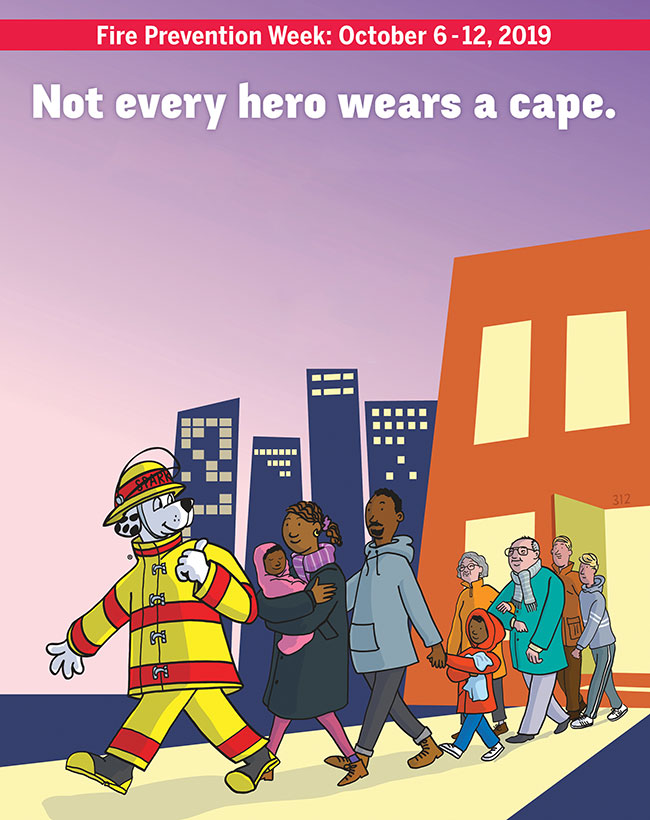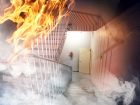
Features
Be a superhero! Plan your escape
July 16, 2019
By
Laura King
 The NFPA’s Fire Prevention Week website has turnkey resources available to fire departments and consumers in an effort to encourage people to think about planning and practising escape plans. Photo credits: NFPA
The NFPA’s Fire Prevention Week website has turnkey resources available to fire departments and consumers in an effort to encourage people to think about planning and practising escape plans. Photo credits: NFPA When I ask audiences across Canada who “does” Fire Prevention Week, every hand in the room shoots up, with great enthusiasm.
When I ask specifically what fire departments ”do” for Fire Prevention Week, the responses vary but I often hear, “We go into the schools,” or, “We do an open house.” Which is fantastic!
But today’s consumers – the people in your communities, your target audiences – receive and absorb information differently than they used to. They’re picky about the messages they receive.
Consumers want – and demand – to be engaged and entertained; they want information delivered to them in ways they can use, share, teach and act upon. And so do you.
Essentially, to “do” Fire Prevention Week, you need a pre-plan.
NFPA’s Fire Prevention Week website – www.firepreventionweek.org – provides turnkey resources for fire departments and consumers – everything your department needs to “do” Fire Prevention Week: videos, images, lessons, activities, tip sheets, social-media posts, press releases, proclamations (local and provincial/territorial), talking points, and games and apps.
The 2019 Fire Prevention Week theme – Not every hero wears a cape. Plan and practice your escape. – lends itself brilliantly to fun, engagement, creativity and interactive activities.
Imagine your volunteer firefighters or your C platoon decked out in superhero capes and masks, at a local community centre during Fire Prevention Week, helping families prepare escape plans. Now that’s an Instagram-able moment.
What’s more, NFPA has listened to the users of Fire Prevention Week (FPW) material, and for 2019 offers three images – an urban scene, a rural scene and a combination urban/rural scene (notice the diversity represented in each image).
Departments can choose and use the FPW artwork that best reflects their audiences.
So how do you “do” Fire Prevention Week?
Start by going to www.firepreventionweek.org. There are four tabs across the top of the page:
- Make your plan
- About
- Toolkit
- Resources
Everything on the webpage is free to download; you need only a printer and some creative juices.
If your department lacks a quality printer, why not partner with a local print or copy shop to have materials produced, and promote the store during your FPW event as a partner in fire safety? Dollars to doughnuts the copy shop will offer you a deal or even freebies.
What will you find at each of the four tabs on the www.firepreventionweek.org web page?
- Make your plan: This section includes a home fire-escape plan grid with the 2019 theme artwork, a fire-escape checklist (you can find additional escape-planning activities for children at www.sparky.org), and a fire-safety checklist for caregivers of older adults. Older adults are a risk group in most Canadian communities; be sure to include them in your Fire Prevention Week planning. Use the eight fire-prevention messages in NFPA’s Remembering When program (www.nfpa.org/rememberingwhen) to enhance your visits with older adults.
- About: Do you know how and why Fire Prevention Week started? The story, of course, goes that Mrs. O’Leary’s cow kicked over a lantern that started the Great Chicago Fire in 1911. Fire Prevention Day, then Fire Prevention Week, were instituted to educate people about fire safety and prevention (thank goodness). In Canada, Fire Prevention Week was adopted in 1923 and is our longest-running safety campaign. We know Thanksgiving always falls during Fire Prevention Week (Oct. 6-12), which essentially shortens FPW for us Canucks. To that end, NFPA no longer includes the FPW dates on the big, outdoor FPW banners. This extends the life of the banners (and your limited pub-ed budget) and enables departments to use the theme all year long. Many Canadian departments hold their FPW events in late August or September to guarantee good weather and a good turnout.
- Toolkit: Oh Canada! All the items in the Fire Prevention Week toolkit – the press release, proclamations, talking points and a fundraising letter – have been Canadian-ized, with Canadian spellings, metric measurements, and Canadian data. All you have to do is fill in the blanks with your department’s information and voila, you have an instant press kit to send to local reporters, and a framework for doing interviews, talking to residents and posting to social media. You’re welcome.
- Resources: This is the gold mine. Images, social media posts, videos, lesson plans, activities, tip sheets, games and apps, story books, templates for press releases, proclamations, talking points, and fundraising – all in one place, and all ready to download.
Now that you know how and where to find the resources, how can you best use them?
Preschools and daycares (ages 2-4): NFPA’s key messages for young children – which can be found in our Educational Message Desk Reference at www.nfpa.org/Public-Education/Resources are:
- Firefighters are community helpers
- Know the sound of the smoke alarm
- Get outside and stay outside
(Just a reminder that NFPA teaches stop, drop and roll to children starting in Grade 1 – focus on the messages above for younger children).
For preschools and daycares, use the Learn Not to Burn resources at www.sparkyschoolhouse.org and the Fire Prevention Week Make Your Plan grid. Show the Fire Safety Minute video. While you’re on that page, check out the lesson plans and games and apps.
Primary to Grade 2: Show the Fire Safety Minute video, and the key messages on the “Make your plan” tab at www.firepreventionweek.org. Follow the plan on the web page – map it out, mark the location of smoke alarms, pick a meeting place, make sure everyone knows how to call 911. Click on “make a plan” and use the provided grid to have children draw their homes and find two ways out of every room. Go to the “resources” tab and find an activity you like – there are activities and videos for each age group. Wear your superhero capes and masks!
Grades 3-6: Show the Fire Safety Minute or Making a Home Fire Escape video. Go to the “resources” tab and choose an activity. Try the games and apps with this group. They may also really enjoy the Great Chicago Fire video – and their teachers will love the historical aspect. Show participants how to climb out a window and help a volunteer do so.
Adolescents: This is a tough group to reach. They’re on Instagram and Snapchat. Ask them to follow your department, and then be sure to post catchy items targeted specifically to them. Use GIFs and hashtags to develop a following (start now, not in October). Include the Fire Safety Minute video in your posts. Pose questions: Do you know two ways out of every room? Could you escape a fire in your home? Provide links to www.firepreventionweek.org. Run contests with prizes.
Community groups (children): Brownies, girl guides, scouts, boys and girls clubs, YMCA … use the apps on the www.firepreventionweek.org page and get everyone involved. Show the Fire Safety Minute video and/or the Making a Home Fire Escape plan video, and ask the participants to think about two ways out of every room in their homes. Ask for volunteers to describe the two ways out. Show participants how to climb out a window and help a volunteer do so. Use the NFPA 10-minute mini-lesson on calling 911 from a mobile phone. Ask participants what they know about Justice League and superheroes (just for fun) and why even superheroes need help and partnerships to save the world. Wear your superhero capes and masks.
Older adults who live in their own homes: Older adults love your company. Choose one key message – plan and practise your escape – and provide the older-adult checklist (click the “resources” tab). Provide the escape-planning tip sheet (also in the “resources” section along with lots of other tip sheets). Older adults may not be able to move quickly or get out of a bedroom if there is smoke or fire. Make sure you know your department’s shelter-in-place policies. Remind older adults to have cell phones nearby, along with eyeglasses, footwear and towels to put around the door frame. Make sure they can hear the smoke alarm. Use the NFPA messaging desk reference to ensure your messaging is accurate. It’s free and downloadable. Show the Fire Safety Minute video or the Making a Home Fire Escape plan video. The Chicago Fire of 1870 video may also resonate with this group. Use the fire safety checklist for caregivers of older adults. Show the Fire Safety Minute video. Most importantly, have prizes and snacks.
Autumn home show or fall fair: You will have a varied audience and likely only a few minutes to get your message across – with the competition from the food vendors. Choose one topic and focus on it – plan and practise your escape. Explain that homes today burn fast because of lightweight construction and combustibles – families have just two minutes to escape once they hear the smoke alarm. Ask folks to identify two ways out of every room. Have the home fire-escape plan grids available. Show the Fire Safety Minute video. Have prizes.
No matter when or where your FPW activities occur, make sure you include messages for folks who have mobility challenges or are deaf or hard of hearing. Check out NFPA’s resources at www.nfpa.org/Public-Education/By-topic/People-at-risk/People-with-disabilities/Educational-materials.
What else can you do in your communities?
You don’t have to host an FPW “event,” rather, think about the activities that happen in your area every day, and have others help you get the message out – that’s true community risk reduction.
- Provide your municipality’s corporate communications department with the FPW images by going to www.nfpa.org/fpw under the “resources” tab to use in social-media posts. The images are available in myriad sizes, in jpeg and PDF formats. Do this now; most communications folks require a lot of lead time.
- Ask your mayor, councillors and other local influencers to tweet/post about the FPW theme and use the hashtag #FirePreventionWeek. Have a contest to see who can get more followers during the week and have that councillor be an honourary firefighter for a day (just a thought). Get your kids (not kidding) to help you with Instagram hashtags. Instagram is different from Facebook and Twitter. Posting the same things on all three platforms fails to maximize the audience potential. Adding hashtags increases followers and spreads the messages more effectively. Try #firepreventionweek, #firesafety, #Sparky, #fireprevention.
- Invite sports teams – the local rep or Junior A hockey club, for example – to have an FPW theme night. Ask the announcer to read FPW messaging at the end of each period. Post safety tip sheets in the arena. Hand out FPW magnets. Get Sparky to drop the puck.
- Have your firefighters bag groceries on Saturday, or, better yet, carry the bags to shoppers’ vehicles. On the way, explain the importance of home escape plans and provide handouts. A two-minute talk with a firefighter in a grocery-store parking lot will be a full-fledged conversation at that night’s family dinner.
- Ask local media to play the Fire Safety Minute video (anyone can use it) on their websites, social media feeds and YouTube channels. Have the local reporter demonstrate climbing out a window with a smoke alarm sounding in the background. Reporters love this sort of thing.
At NFPA, our mandate is to help save lives with information, knowledge and passion.
It’s a big word.
We can protect it together, doing little things that make a difference.
Laura King is the NFPA’s public-education representative for Canada. Contact her at canadacrr@nfpa.org; follow her on Twitter at @LauraKingNFPA.
Print this page

